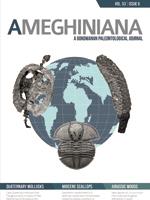The paleobiological history of South America has long captivated amateurs and researchers. The book titled “Horned armadillos and rafting monkeys. The fascinating fossil mammals of South America”is not only a well-written volume on mammal paleontology, but a geographical and temporal journey to ancient South America. It is available in electronic and hardcover formats; indeed, those who also value books as objects should consider the plus of the nice Chinese manufacture of the printed edition. Its 320 pages are fully illustrated with photographs of paleontological localities and fossil specimens, as well as interesting reconstructions of extinct mammals by Velizar Simenovski. Reconstructions of mammals in paleontology are not always as daring as those of dinosaurs, so re-creations such as the two male Trigodon notoungulates engaged in fighting behavior during the mating season are very welcome.
The contents are structured as three main parts, so as to divide the Cenozoic mammalian history into main events without disregarding interesting vertebrates such as the horned turtle Niolamia argentina. Each part is characterized referencing classic localities of Argentina, Bolivia, Brazil, Chile, and Colombia. The thematic core of the book is preceded by an essential introduction in the first two chapters, titled Time and Geography and Introduction to Mammals, respectively. Within them, the author successfully explains important technical aspects of paleomammalogical work, making the subject matter easier to understand for nonspecialized readers. The first chapter introduces the South American Land Mammal Ages (SALMAs) in a very updated review and explaining these units as what they are, i.e. biochronological divisions. This chapter also represents an important step from the classical view of Simpson Splendid Isolation, dealing with the more important events in South American biotic evolution (e.g:. FABI, GABI, TADI). The second chapter is a brief summary of mammal taxonomy with clear characterizations of most orders found in Cenozoic fossil sites.
Part I of the book concerns the First American Biotic Interchange (FABI), which signals the beginning of the Early South American Phase in mammalian history, and the Trans-Atlantic Dispersal Interval (TADI), with a review of four important localities including their fossil mammal content. The opening site is the amazing early Paleocene fauna of Tiupampa in Bolivia, followed by the early Eocene of Itaboraí in Brazil, and two Patagonian localities in Argentina, Gran Barranca representing the middle Eocene and Gran Hondonada for the late Eocene. As in the rest of the chapters, several examples of the main fossil mammal groups are characterized by size, ecological characteristics, evolutionary relationships, detailed photographs of specimens, and creative reconstructions of several taxa. Explanations of the meaning of species names also provide another perspective to bring the reader closer to these mammals.
The paleontological sites discussed in the second part of the book are very representative of the Oligocene and Miocene of South America. The classical localities of Tinguiririca and Chucal in Chile, Salla and Quebrada Honda in Bolivia, La Venta in Colombia, and Santa Cruz and Arroyo Chasicó in Argentina, are represented by a selected set of species. This enables geographical comparisons in cases such as those of Chucal and Santa Cruz, whose faunas share a similar stratigraphic range. This is a very welcome approach and certainly will be key to characterize SALMAs in a continent where the North-South component spans a wide latitudinal range.
The most famous biotic event in South American history, the GABI, is delineated in Part III and exemplified by Acre in Brazil, Tarija in Bolivia and two locations in Argentina: Catamarca and Chapadmalal. Those paleontologists who have abandoned Rosendo Pascual's legacy of SALMAs in favor of local Ages/Stages will probably be uncomfortable with the Mammal Age references for these sites. Each locality is presented through concise and very useful syntheses, which gives the reader an interesting context with references to the main lithostratigraphic units, as well as paleoclimatic and faunistic details.
The ‘Further Reading’ section includes a useful list of bibliographic references divided into three general themes: fossil sites, taxonomic groups, and miscellaneous topics. The most relevant and recently published articles in these subjects are mentioned here and, more interestingly, a brief comment is provided indicating the main goal of each of these works. This section is undoubtedly a great source of information. Also useful in themselves are the long Appendices. The first two present the alphabetical list of species found in the text and their taxonomy. The rest provide the complete faunal list for each site, with specific bibliography. Technical terms are explained in a Glossary and all illustrations, charts, tables, fossil sites and taxa, clearly ordered in an Index.
To sum up, the absence of the early Paleocene locality Punta Peligro and of references to non-therian mammalian lineages will be missed by some readers. But the correct use of formal units (e.g. avoiding the use of uppercase for “early” when early Eocene is mentioned instead of Ypresian) will satisfy the scrupulous readers. Neither professional paleontologists nor amateurs will be disappointed in this great book.





